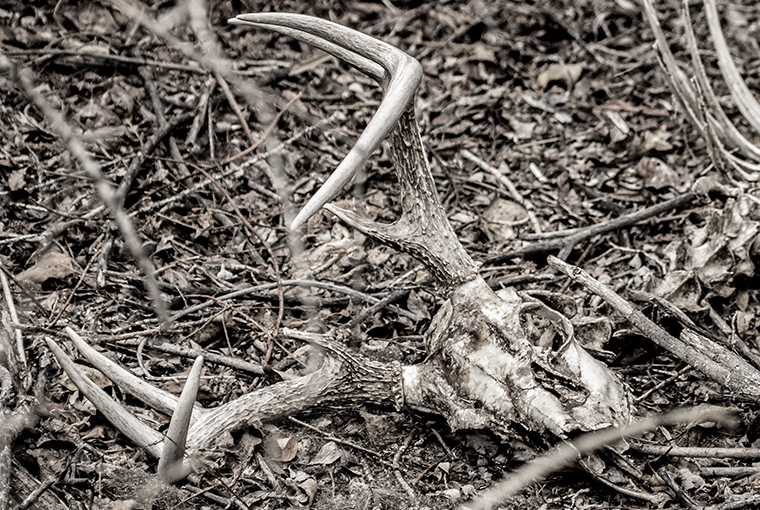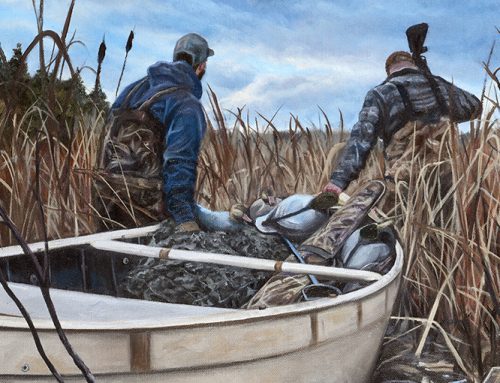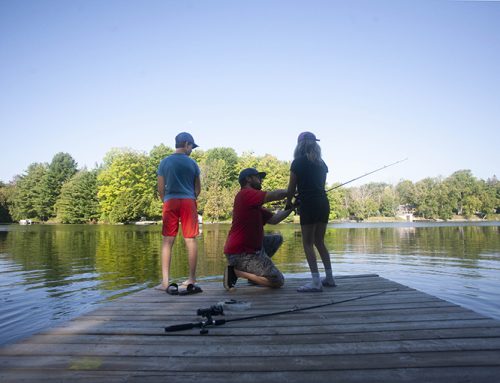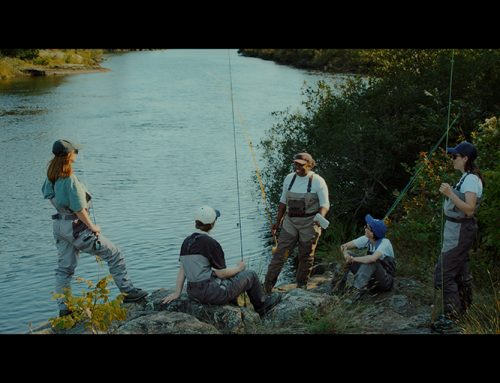
Imagine an autumn in which our deer, moose, elk, and caribou herds have been decimated by a disease that has no cure. Imagine hunting when you cannot trust the edibility of the venison you harvest. Then imagine this is the new normal.
Imagine this scenario and you will have a sense of what an unchecked chronic wasting disease (CWD) outbreak would look like in Ontario. CWD is a game changer — for the animals it affects, for the hunters who pursue them, for Indigenous people, for farmers, for tourism operators, for anyone who values a healthy ecosystem.
The greatest threat
CWD was first reported in a Colorado research facility in 1967. Since then its range has steadily expanded — and now what used to be considered a western deer disease has been found in 26 states, including every Great Lakes state except Indiana. Alberta and Saskatchewan have been also been battling it since the 2000s and it was discovered in Quebec in 2018. The latter is particularly troubling for Ontarians since the game farm that housed the diseased red deer lies within 15 kilometres of the Ottawa River, which is considered a permeable barrier that deer could cross by swimming, or, when the river freezes, on foot.
Maps detailing CWD detections from 2000 to 2018 depict its alarming expansion. CWD looks like it’s becoming an eastern disease, too.
That’s cause for alarm.

The disease is often likened to bovine spongiform encephalopathy (BSE, or mad cow disease). The difference is that CWD affects cervids (in Canada, deer, elk, moose, caribou) and is not yet known to affect humans.
Both diseases belong to a group known as transmissible spongiform encephalopathies (TSE). Spongiform describes the appearance of the affected animal’s brain after the disease has inflicted countless microscopic holes in it. The scientific consensus is that TSEs are prion-associated diseases that attack the victim’s brain and nervous system.
Outward symptoms are drastic weight loss, stumbling, no fear around people, general lack of coordination, listlessness, and drooping ears. CWD infected deer also exhibit excessive thirst, urination, or drooling. CWD-killed deer are often found near water.
The disease is a death sentence for cervids. In 2004, Canada’s Expert Scientific panel on CWD called it “arguably, the greatest known threat to deer.”
Currently, there are no practical live animal tests, preventative vaccines, or cures. Highly infectious, it spreads steadily throughout any deer, elk, moose, caribou, or reindeer herds exposed to it. A leading expert in TSEs at the Canadian Food Inspection Agency characterized mad cow disease as the mildest, least virulent, and easiest TSE to contain — and CWD as the most severe. Left unchecked, it can potentially reduce or even eliminate entire elk, deer, moose, or caribou populations.
Direct and indirect transmission
So how does a cervid get CWD?
The short answer is by ingesting or inhaling CWD-associated prions directly from an infected animal or indirectly from a contaminated environment.
Direct “nose to nose” transmission from one animal to another is most common, especially at the beginning of an outbreak. This occurs when a non-infected cervid inhales or ingests lethal CWD prions, which can be shed in saliva, nasal secretions, urine, feces, blood, skin, birthing matter, antler velvet, or an animal’s carcass. It can also be transmitted from mother to fetus.
The risk of contracting the disease from a contaminated environment becomes more likely as the disease establishes in an area. Environmental uptake happens when a cervid ingests or inhales CWD-associated prions in soil, water, on vegetation, or other surfaces such as hay bales or spilled grain.
Worse, CWD-associated prions persist indefinitely in the environment, essentially, laying in wait for a cervid to ingest or inhale them. This presents the nightmarish scenario of a healthy animal acquiring the disease years after CWD-infected animals roamed an area.
There’s also concern that CWD-related prions might be spread in the scat of scavengers that consume dead infected animals. If a raven or turkey vulture eats parts of a CWD-infested deer, it’s conceivable CWD-associated prions could be dropped in feces miles away, creating the possibility of a new outbreak.
The longer it persists, the worse it gets
The disease does not merely reduce a cervid population by killing off infected animals. It also reduces numbers by altering the herd’s demographics and capacity to repopulate. The longer CWD remains established in a population the greater the possibility of a severe down-ward spiral.
Cervids suffering from CWD have significantly shorter life expectancies. A 2016 study published by Michael D. Samuel and Daniel J. Storm of the University of Wisconsin-Madison found the life expectancy of CWD-infected mule deer and whitetail deer was approximately 1.5 to 2.5 years and infected elk had a life expectancy of approximately four years. CWD incubates for 18 months before it presents clinical signs. Once those outward signs are evident death could occur in a matter of days to more than a year.
Dr. Bryan Richards, the emerging disease coordinator of the United States Geological Survey’s (USGS) National Wildlife Health Center, was involved in a Wyoming study that determined that deer that did not have CWD in the population had a 76% chance of surviving to the next year. If they did, they only had a 32% chance of survival for a year.
In Wisconsin, where much research on CWD is taking place, two trends have been noticed. The first is that prevalence of the disease tends to increase with age. The second is that the prevalence of CWD has increased within each age group over time, and that growth has been exponential.
For example, in 2002-2005 less than .033% of four- to five-year-old deer in the state had CWD. In the period of 2015-2017, however, that rose to 0.500%, a large increase in a little over a decade.
The Samuel-Storm study also found that adult bucks are hardest hit. They contracted the disease at three to four times the rate of adult does. The reason is unclear, but it could have to do with behaviours that expose it to more risk. Adult male deer with CWD are more likely to die than adult males without it, or even CWD-positive females, the study found. That’s why one notable consequence of a CWD outbreak is fewer and younger bucks in the affected herd.
Researchers noted that once a doe contracts CWD its average longevity is six months, compared to two years without the disease. Fewer does mean population decline, according to the researchers. Four other studies on white-tailed deer, mule deer, and elk in Colorado and Wyoming concur. In each, population growth was in decline and mortality in CWD-infected elk or deer was much higher than in healthy animals.
Risk varies among species
Some cervid species are hit harder than others. For instance, Dr. Evelyn Merrill of the University of Alberta noted that 86% of the 919 positive cases of CWD found in Alberta since 2005 have been in mule deer. This is thought to be related to their typically larger group sizes and how landscape influences and channels their movement. Also, mule deer tend to cover more territory than whitetails.
Moose are rarely infected by CWD and it’s believed they cannot pass it between individuals. Caribou have been somewhat protected by their isolation from farms and man, but Saskatchewan’s Ministry of the Environment believes that in the long-term, CWD will likely spread into the boreal forest, and into moose and caribou populations.
The latter would be disastrous, since caribou seem particularly suited to spreading CWD due to their large, concentrated herds, social interactions, and the overlap of different populations across northern Canada. Basically, if the disease enters caribou range, the potential exists for it to spread to every herd but the one on Baffin Island.
The human vector
Sadly, people have played a large role in spreading the disease beyond its initial origin in Colorado and Wyoming.
On a broad scale, this has been through government, special interest groups, and orchestrated campaigns that have set hunters against game agencies. On an individual scale, it sometimes happens when hunters wilfully disregard or are ignorant of requirements regarding the transport, reporting, or testing of game.
Governments that have allowed CWD to make headway have most often done so through inaction, poor preventative measures, or bad or indecisive policies. Key failings have been poor initial detection programs, slow response, and/or inadequate containment.
In some cases, the initial response was appropriate but was then watered down due to public protest when drastic measures (such as culling) were needed most. In many jurisdictions where the disease is now firmly established, it’s because politics and public opinion trumped science.
Game farming and high-fence hunting operations are examples of industries that have made CWD management much more difficult. Despite best efforts, both have a long history of introducing CWD-infected animals to new provinces or states, including the recent out-break in Quebec. This generally happens when a CWD–infected animal is unknowingly imported from other farms.
The first confirmed cases of CWD in Saskatchewan, Alberta, and several U.S. states were in game farms. By the time the first wild mule deer with CWD was identified in Saskatchewan in 2000, 230 captive animals on 39 game farms in that province had already been identified as CWD-positive.
It’s not difficult to find examples of enclosed hunting operations unknowingly bringing in CWD-infected trophy animals across state lines to meet customer demand. What is surprising is that in some states, game farms and high-fenced hunting operations remain open even after CWD has been discovered in their herds.
If the disease jumps from captive deer to wild animals, it’s typically by way of escaped animals, and that happens more frequently than you might expect. For example, in Pennsylvania between 2008 and 2017, there were 487 documented cases of cervid escapes from game farms. Even if escapes don’t happen, there’s the risk of wild animals making contact with captive animals or their feed at the fence.
Hunters haven’t helped
Individually, hunters have also played a part in potentially spreading the disease by moving carcasses illegally from CWD-positive areas to other areas of the country. As previously mentioned, this is either wilfully done or through a lack of understanding of regulations that, in many jurisdictions, prohibit hunters from transporting brain, spinal column tissue, or other potentially infected animal matter across state or provincial lines.
The hunting community’s support and use of high-fence hunting enclosures has encouraged the transfer of CWD-infected deer across state lines in the United Sates.
Some hunting groups have also actively campaigned against government-led containment measures for CWD outbreaks. Many have publicly argued that the impact of the disease was overblown and that the cure (essentially major culling) was worse than the disease.
Much misinformation about CWD has been spread too, including the suggestion that the disease is not spreading — which is demonstrably untrue.
Prevention on the front lines
Manitoba has done an admirable job keeping CWD at bay thus far, especially since it borders Saskatchewan where the disease is prevalent.
The province had 90 elk farms in 1996, which were allowed to capture native elk, too.
In 2002, when CWD was taking hold in Alberta and Saskatchewan, Manitoba prohibited elk imports from all other jurisdictions, un-less they were going directly to slaughter. (There are currently no abattoirs in the province that have adequate bio-security capacity so im-portation for slaughter is not an issue.)
In 2007, the province allowed importation of live captive elk from jurisdictions that had been CWD-free for the last five years with a surveillance program similar to Manitoba’s. The importation of exotic and native cervids and unprocessed cervid carcasses was banned. Deboned or processed meats are allowed, as are capes and antlers so long as they remain in sealed containers. Cervid bodily fluids, com-monly used for deer lures, were banned.
CWD surveillance zones along Manitoba’s Saskatchewan and U.S. borders also have special regulations. Licenced hunters must submit samples of all heads of elk and white-tailed deer for testing.
Baiting is illegal province-wide and feeding wildlife is prohibited in disease control areas.
The province flies helicopter risk assessment surveys counting populations, checking for ear tags, looking for unnatural concentrations of animals, accidental or illegal feeding sites, and illegal baiting. The province encourages farmers to create hay storage fences to prevent deer from gathering to graze on bales.
Lastly, Manitoba has prepared an aggressive action plan to deal with CWD outbreaks should they arise in captive facilities or wild populations.
These policies and good communication with hunters and the public have, thus far, kept Manitoba CWD-free.
Eradicating an outbreak
New York State is the only North American jurisdiction that has contained and eliminated a CWD outbreak — and that’s no small feat.
Even prior to its CWD outbreak, the state was taking precautions by implementing bans on feeding, banning importation of live deer and elk, putting restrictions on parts and carcasses, and certifying herds on game farms. It also tested approximately 3,500 deer for CWD between 2002 and 2004.
The trouble began in March 2005 when CWD surveillance found seven CWD-positive deer in slightly over 300 deer sampled around Oneida, New York.
Luckily, the state was prepared and acted quickly. Federal and state agencies, Cornell University, and State University of New York Environmental Science and Forestry assets coordinated their efforts to enact Operation Oneida, which established a 10-mile perimeter around locations where CWD-positive deer had been found. A command structure coordinated efforts and government marksmen began culling deer within the perimeter at dawn, dusk, and overnight using night-vision gear. The shooters used baited sites, traditional stands, and organized drives, and collection teams immediately gathered the culled animals and road kills for testing. Access crews worked ahead, ar-ranged hunting permission for marksmen on properties within the containment zone, and the public was kept informed and updated by meetings, press releases, brochures, and websites, as public cooperation was deemed critical.
By April, 317 more deer had been shot and tested, with two additional cases of CWD found. Regulations were amended to add mandatory check-in within the zone, which included tissue sampling for CWD testing.
Within the containment zone, a ban was implemented on possessing road-killed deer, deer and elk urine, and deer rehabilitation.
In 2005, 1,610 hunter-harvested deer were processed and tested in the containment zone and those hunters received the results of CWD testing within a week. State-wide, 8,200 hunter-harvested deer were also tested. Field surveys of taxidermists and game processors were conducted, and game farm herds were assessed. Taxidermists also collected samples for testing.
This allowed state officials to determine high-risk areas for testing and surveillance, many of them on the border with Pennsylvania, an-other CWD-affected state. New York state has tested more than 49,000 deer since the 2005 outbreak and no other CWD-positive deer have been found.
A good position to be in
In terms of CWD, Ontario is in a good place. The Great Lakes and other waterways form a formidable barrier to the south. Manitoba has been vigilant to the west. Quebec, till recently, has been CWD-free to the east.
Still, the Ministry of Natural Resources and Forestry (MNRF) is being proactive. In 2005, it created a plan to establish a coordinated approach to preventing and responding to CWD in wild Ontario cervids. Surveillance teams are active each fall and since 2002, have tested 12,400 animals, without a single positive case.
In mid-June, the province posted a notice on the Environmental Registry of Ontario asking for public comment on an updated version of its 2005 CWD plan. It proposes a multi-agency approach, with the MNRF generally taking the lead on CWD found in wild deer populations and the Ontario Ministry of Agriculture, Food and Rural Affairs leading on captive cervid outbreaks. If enacted, the changes could include the use of the Invasive Species Act to provide more legislative powers to respond quickly and decisively to an outbreak.
These changes are indicators that the province is on the right track. They show a recognition of the social, cultural, and economic bene-fits deer provide to Indigenous people, hunters, and wildlife enthusiasts. In 2017 alone, deer hunting added $275 million to the provincial economy.
CWD, the future, and you
CWD is expanding across North America — that’s a fact. But, as New York State and, hopefully, Quebec have proven, it can be eradicated by a comprehensive, determined, and timely counterattack.
That’s why hunters need to be part of the solution. We must follow regulations designed to thwart the disease, such as proper transportation of carcasses across state and provincial lines. We must cooperate with the MNRF regarding CWD testing and regulations. Most importantly, we must create awareness about the disease and continually remind our politicians that this is a critically important public health and environmental issue.
We can start by becoming informed and critically weighing arguments that try to diminish the warnings and expertise of virtually every game agency and credible wildlife and prion-based researcher in the U.S. and Canada.
In every case where progress has been made against CWD, public support has been behind it, and the many failures have been due to politicians and game agencies bowing to public pressure to back off at critical times.
If we lose the battle and CWD takes hold, our deer, moose, and elk hunting will very likely never be the same. Hunter numbers will diminish, conservation dollars will ebb, and the traditions we cherish — deer camp, venison tenderloin, time with family and like-minded friends under the autumn canopy — will all fade and waste away like the deer herds we love.
We can do better.
Click here and here to read more about CWD.
Originally published in the August 2019 issue of Ontario OUT of DOORS magazine.






I have heard and read about CWD in the past but I did not realize how wide spread and dangerous too our wild animals it really is.
Thank you for this information.
Ed Bailes Creston B C